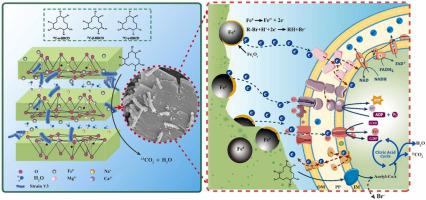Journal of Hazardous Materials ( IF 12.2 ) Pub Date : 2023-05-29 , DOI: 10.1016/j.jhazmat.2023.131739 Tianyu Li 1 , Yingyuan Lu 1 , Lei Liu 1 , Yuzhe He 1 , Jingfei Huang 2 , Xingxing Peng 3

|
The coupling of modified nanoscale zero-valent iron (nZVI) with organohalide-degrading bacteria provides a promising solution for the remediation of hexabromocyclododecane (HBCD)-contaminated environments. However, the interactions between modified nZVI and dehalogenase bacteria are intricate, and the mechanisms of synergistic action and electron transfer are not clear, and requires further specific investigation. In this study, HBCD was used as a model pollutant, and stable isotope analysis revealed that organic montmorillonite (OMt)-supported nZVI coupled with the degrading bacterial strain Citrobacter sp. Y3 (nZVI/OMt–Y3) can use [13C]HBCD as the sole carbon source and degrade or even mineralise it into 13CO2 with a maximum conversion rate of 100% within approximately 5 days. Analysis of the intermediates showed that the degradation of HBCD mainly involves three different pathways: dehydrobromination, hydroxylation, and debromination. The proteomics results showed that nZVI introduction promoted the transport of electrons and debromination. Combining the results from XPS, FTIR, and Raman spectroscopy with the analysis results of proteinomics and biodegradation products, we verified the process of electron transport and proposed a metabolic mechanism of HBCD degradation by the nZVI/OMt–Y3. Moreover, this study provides insightful avenues and models for the further remediation of HBCD and other similar pollutants in the environment.
中文翻译:

使用蒙脱石负载的纳米零价铁和柠檬酸杆菌有效降解六溴环十二烷。Y3
改性纳米零价铁(nZVI)与有机卤化物降解细菌的结合为修复六溴环十二烷(HBCD)污染的环境提供了一种有前景的解决方案。然而,修饰后的nZVI与脱卤酶细菌之间的相互作用错综复杂,协同作用和电子转移的机制尚不清楚,需要进一步具体研究。在本研究中,六溴环十二烷 (HBCD) 被用作模型污染物,稳定同位素分析表明,有机蒙脱土 (OMt) 支持的 nZVI 与降解细菌菌株柠檬酸杆菌 ( Citrobacter sp.) 结合。Y3 (nZVI/OMt–Y3)可以使用[ 13 C]HBCD作为唯一碳源,并将其降解甚至矿化为13 CO 2大约 5 天内最高转化率可达 100%。对中间体的分析表明,HBCD的降解主要涉及三种不同的途径:脱溴化氢、羟基化和脱溴化。蛋白质组学结果表明nZVI的引入促进了电子的传输和脱溴。结合XPS、FTIR和拉曼光谱的结果以及蛋白质组学和生物降解产物的分析结果,我们验证了电子传递过程,并提出了nZVI/OMt-Y3降解HBCD的代谢机制。此外,这项研究为进一步修复环境中的六溴环十二烷和其他类似污染物提供了富有洞察力的途径和模型。










































 京公网安备 11010802027423号
京公网安备 11010802027423号